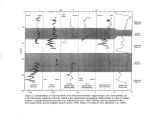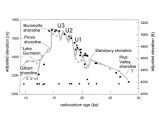| OCR Text |
Show Charles G. ( Jack) Oviatt Department of Geology Thompson Hall Kansas State University Manhattan, KS 66506 BONNEVILLE BASIN LACUSTRINE HISTORY Systematic studies of ancient lakes in the Bonneville basin began with the work of Grove Karl Gilbert, who published his monograph on Lake Bonneville in 1890. By the time of the 1947 symposium on the glacial and postglacial history of the Great Basin, Gilbert's reconstruction of the lake's history had been reinterpreted by only a few people ( Sack, 1989). In subsequent decades, however, many new chronologies have been proposed. In this paper I will first briefly review knowledge of Bonneville basin lakes as of 1947, with emphasis on the contributions of Ernst Antevs. The second part of the paper will be a summary of the current knowledge of the lacustrine history. Lakes began forming in the Bonneville basin during the middle Tertiary ( Miocene) with the initiation of tectonic extention in the region. Gilbert ( 1890) noted a few exposures of Tertiary lake deposits in the Bonneville basin, but very little was know about them at the time. Based on the meager evidence he had available, Gilbert made an insightful comment concerning the Tertiary history of the basin; he thought it was ". .. possible that the Bonneville Basin continuously held a lake which, as the land rose and fell unequally, was expanded and contracted, now in one direction, now in another" ( Gilbert, 1890, p. 101). Gilbert ( 1890) reported geomorphic and stratigraphic evidence that suggested Lake Bonneville rose twice to high levels in late Pleistocene time following a long early Pleistocene period of low lakes and alluvial- fan deposition on piedmont slopes. In Gilbert's interpretation, the two late Pleistocene high- lake epochs were represented by lithologically dissimilar stratigraphic units, the Yellow Clay and the White Marl. Gilbert also mapped the Bonneville and Provo shorelines and studied the geomorphology of shoreline depositional features, such as spits, barriers, and deltas. Gilbert's contributions were so great that few credible challenges to his interpretations were published during the first half of the 20th Century ( Sack, 1989). One person who published a number of papers concerning Lake Bonneville history during this period, and who also contributed to the 1947 symposium, was Ernst Antevs. Antevs was convinced that lake fluctuations in the Bonneville basin were correlated with the growth and decay of Northern Hemisphere ice sheets and mountain glaciers, and despite the lack of information on the ages of either the glacial or lacustrine deposits, he presented careful arguments for ways in which they simultaneously varied in size during the late Pleistocene ( Figure 1). Evidence from the mouths of Little Cottonwod and Bells Canyons in the Wasatch Mountains indicated that Lake Bonneville reached its highest shoreline somewhat after the glaciers in those canyons had reached their maximum down- valley extent. Antevs argued that during the late Pleistocene the large North American ice sheets, particularly the Cordilleran ice sheet, attained a size large enough to deflect the polar front far to the south of its mean position in historic time, and that frequent storms carried moisture from the |

































































































































































